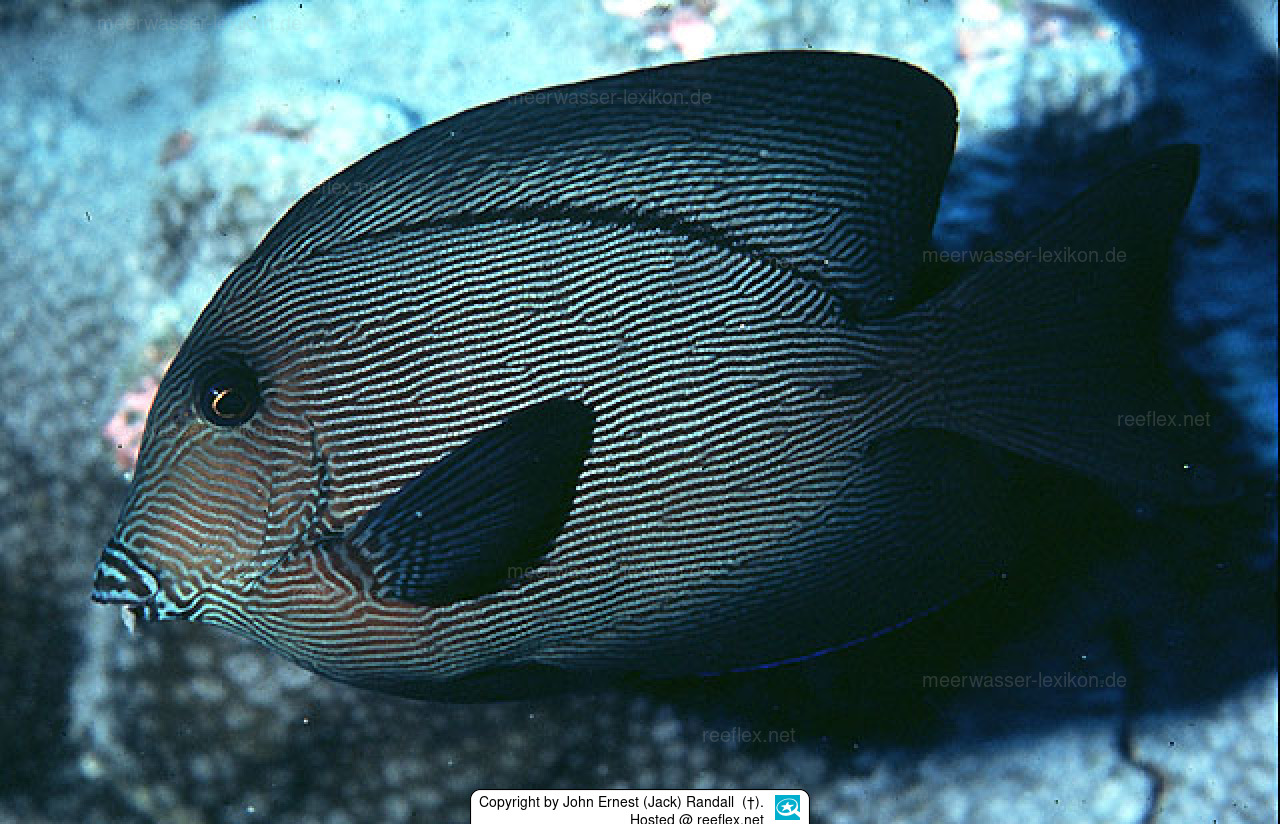Info
Randall, 1955
A very beautiful surgeonfish which almost completely changes its colour when it matures. Juveniles have a bright orange coloured body and head with variegated bright violet and blueish lines, radiating in a kind of herringbone pattern. The fins are tinged violet and become bright blue posteriorly, just above and below the caudal peduncle.
Characteristic for the Chevron tang, as for the other species of the Ctenochaetus genus, are the protrusive pouting mouth including several rows of flexible comb like teeth. These are adapted for scrubbing off short algae and detritus off rocks, sand and other surfaces, then the tang uses its mouth to suck the food up. If you intend to keep a Chevron tang in your aquarium you should give credit to its habit of feeding by adding plenty of live rock. It is a constant grazer and will spend most of the time picking at rocks and sand, nevertheless for its well-being it also needs supplementary food including nori algae, spirulina algae and frozen food e.g. mysid shrimps. As an active swimmer it requires ample of swimming place.
In general the Chevron tang makes a peaceful companion for other tank mates.
The surgeonfishes (Acanthuridae), popular in marine aquaristics, are also called surgeonfishes.
They have horn-like blades in front of the tail root, they use as mainly defensive weapon (defense) against predators, but this sharp weapon is also used in fights among themselves.
Deep cuts in the body of opponents can cause permanent injuries, but often death occurs immediately.
If surgeonfishes are to be kept in pairs in an aquarium, fights between the fishes can be the order of the day, we could observe this several times with the very popular Hawaiian surgeonfish (Zebrasoma flavescens).
The scalpel-like blades can cause deep cuts, this is also true for the careless aquarist who wants to touch or catch the fish with unprotected hands.
Another problem can occur if one wants to catch surgeonfish with a landing net and transfer them after catching, the horn blade can easily get caught in the net.
Caution: Careless handling of the animal can cause deep cuts!
A very beautiful surgeonfish which almost completely changes its colour when it matures. Juveniles have a bright orange coloured body and head with variegated bright violet and blueish lines, radiating in a kind of herringbone pattern. The fins are tinged violet and become bright blue posteriorly, just above and below the caudal peduncle.
Characteristic for the Chevron tang, as for the other species of the Ctenochaetus genus, are the protrusive pouting mouth including several rows of flexible comb like teeth. These are adapted for scrubbing off short algae and detritus off rocks, sand and other surfaces, then the tang uses its mouth to suck the food up. If you intend to keep a Chevron tang in your aquarium you should give credit to its habit of feeding by adding plenty of live rock. It is a constant grazer and will spend most of the time picking at rocks and sand, nevertheless for its well-being it also needs supplementary food including nori algae, spirulina algae and frozen food e.g. mysid shrimps. As an active swimmer it requires ample of swimming place.
In general the Chevron tang makes a peaceful companion for other tank mates.
The surgeonfishes (Acanthuridae), popular in marine aquaristics, are also called surgeonfishes.
They have horn-like blades in front of the tail root, they use as mainly defensive weapon (defense) against predators, but this sharp weapon is also used in fights among themselves.
Deep cuts in the body of opponents can cause permanent injuries, but often death occurs immediately.
If surgeonfishes are to be kept in pairs in an aquarium, fights between the fishes can be the order of the day, we could observe this several times with the very popular Hawaiian surgeonfish (Zebrasoma flavescens).
The scalpel-like blades can cause deep cuts, this is also true for the careless aquarist who wants to touch or catch the fish with unprotected hands.
Another problem can occur if one wants to catch surgeonfish with a landing net and transfer them after catching, the horn blade can easily get caught in the net.
Caution: Careless handling of the animal can cause deep cuts!







 Dr. John Ernest (Jack) Randall (†), Hawaii
Dr. John Ernest (Jack) Randall (†), Hawaii
















